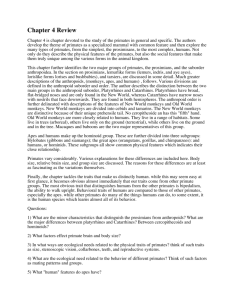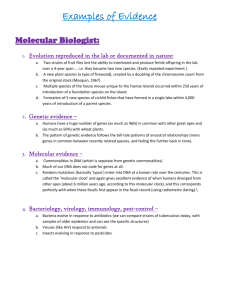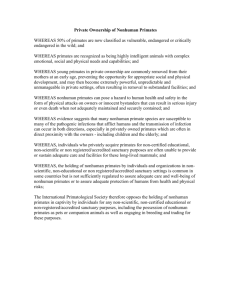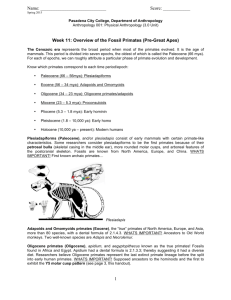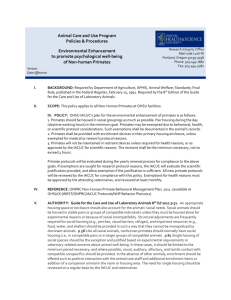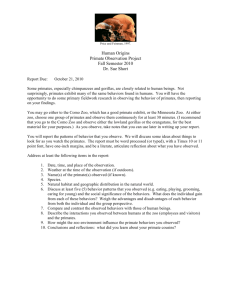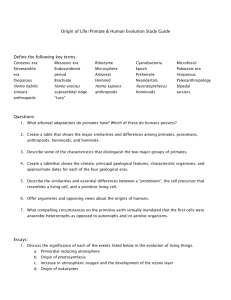PARKINSON'S DISEASE ALZHEIMER'S DISEASE PRESENILE
advertisement
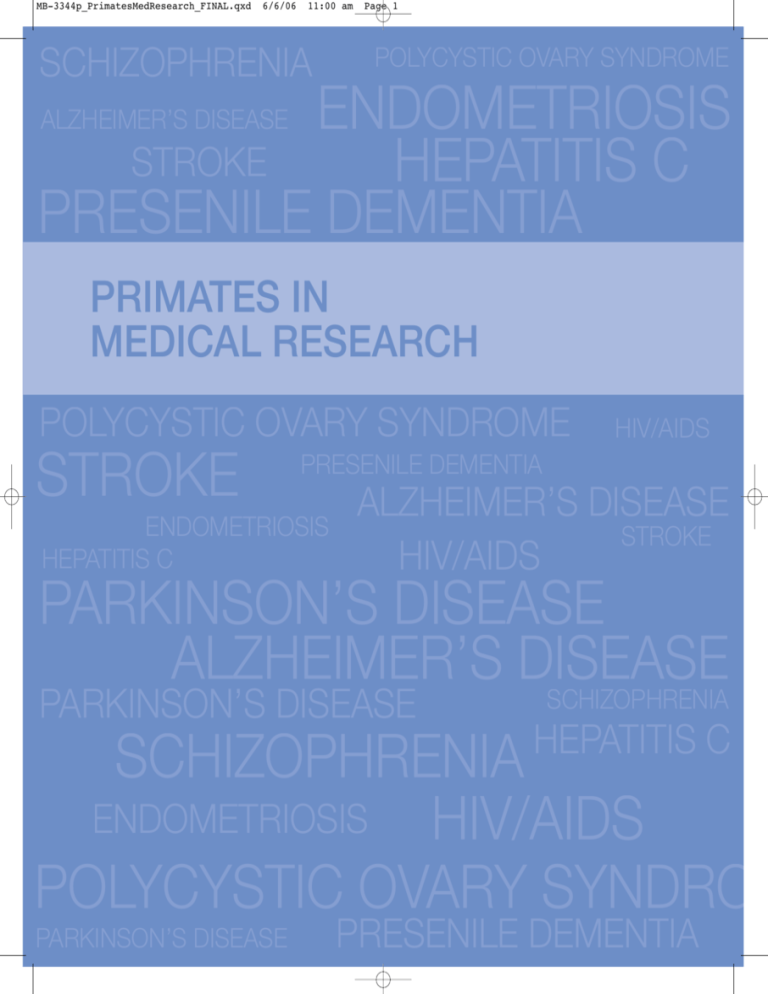
MB-3344p_PrimatesMedResearch_FINAL.qxd 6/6/06 11:00 am SCHIZOPHRENIA Page 1 POLYCYSTIC OVARY SYNDROME ENDOMETRIOSIS STROKE HEPATITIS C PRESENILE DEMENTIA ALZHEIMER’S DISEASE PRIMATES IN MEDICAL RESEARCH POLYCYSTIC OVARY SYNDROME STROKE HIV/AIDS PRESENILE DEMENTIA ENDOMETRIOSIS HEPATITIS C ALZHEIMER’S DISEASE STROKE HIV/AIDS PARKINSON’S DISEASE ALZHEIMER’S DISEASE SCHIZOPHRENIA PARKINSON’S DISEASE HEPATITIS C SCHIZOPHRENIA ENDOMETRIOSIS HIV/AIDS POLYCYSTIC OVARY SYNDRO PARKINSON’S DISEASE PRESENILE DEMENTIA MB-3344p_PrimatesMedResearch_FINAL.qxd 6/6/06 11:00 am Page IFC2 PREFACE This booklet is intended to provide an introduction to the issues raised by the use of primates in medical research. It has been produced by the Medical Research Council (MRC) and the Wellcome Trust, two organisations that fund medical research to improve people’s health and quality of life. When a compelling case can be made, both organisations will consider funding research involving primates. Both organisations also believe, however, that this research should be carried out in an environment of public awareness and support. This booklet therefore aims to provide a balanced and up-to-date account of primate use in medical research. At the time of publication, the MRC and the Wellcome Trust, jointly with the Academy of Medical Sciences and the Royal Society, are conducting an in-depth study on ‘The use of non-human primates in biological and medical research’. This will provide a detailed examination of the scientific basis for the use of primates in research. More information is at: www.nhpstudy.com MB-3344p_PrimatesMedResearch_FINAL.qxd 6/6/06 11:00 am Page 1 CONTENTS Introduction 2 What types of animal are used? 3 The primate family 4 The primate family tree 5 Are primates needed in medical research? 6 Ethical issues 7 Legal responsibilities 8 When are primates used? 9 What has been achieved with research on primates? 10 How are primates currently being used? 11 Key areas of basic and applied research involving primates 12 Parkinson’s disease 12 Reproduction 12 Cognition 13 Vaccines 13 Vision 14 Stroke 14 Promoting a culture of care 15 The 3Rs 15 Examples of the 3Rs in action Standards of welfare 16 17–18 Summary 19 MRC and Wellcome Trust ethical principles 20 More information 21 1 MB-3344p_PrimatesMedResearch_FINAL.qxd 6/6/06 11:00 am Page 2 INTRODUCTION The use of animals in medical research raises strong emotions. Although the number of monkeys used is small (see opposite) their use is particularly sensitive. Whenever possible, medical research avoids the use of animals altogether. Some information, however, cannot currently be obtained without their use – such as the impact of a vaccine on a tissue or organ within the body. To be of relevance to human medicine, animals used in research should show similarities to human biology. In many cases, animals such as mice, rats and fish are sufficiently similar in this respect to provide much useful information. Mice and rats are not identical to people, of course, so we have to be careful about 2 extrapolating from rodents to humans. But they are sufficiently close that most research involving animals can be done on mice and rats. Sometimes, however, the gaps between the biology of rodents and that of people are too wide. The animals most closely related to humans are primates. But this similarity is also what raises most concern: the more ‘humanlike’ an animal is, the less comfortable we feel about using it in research. This booklet outlines the current scientific case for using primates in medical research, the ethics of using primates, a summary of current use, how laboratory animals are cared for, and the legal controls governing animal research in the UK. MB-3344p_PrimatesMedResearch_FINAL.qxd 6/6/06 11:00 am Page 3 WHAT TYPES OF ANIMAL ARE USED? The vast majority of medical research in Great Britain that involves animals is carried out on mice and rats. Only about 0.1 per cent of the animals used in 2004 were primates – 2792 out of 2 778 692. The number of primates used in medical research has remained fairly constant from year to year. In 2004, a total of 2792 monkeys were used in all forms of procedure – 747 marmosets and 2045 macaques. for human use. Various laws (e.g. Directive 2001/83/EEC) require that such products are tested on animals before clinical trials in humans. In 2004, only 288 monkeys were used in fundamental scientific research aimed at understanding human function and disease – about 0.01 per cent of all animals used. Since 1998, neither primates nor any other animals have been used to test cosmetics products in the UK. Most of these monkeys are used by pharmaceutical companies to test the safety and effectiveness of drugs and vaccines Animals used in scientific procedures in 2004 Mice (67%) Rats (16%) Fish (7%) Birds (4%) Other mammals (4%) Other rodents 1%) Reptile/amphibians (1%) Source: Statistics of Scientific Procedures on Living Animals: Great Britain 2004. www.officialdocuments.co.uk/document/cm67/6713/6713.asp Examples Humans Other apes Gorilla, chimp, orang-utan Non-human primates Macaque, marmoset Use in medical research Comment Volunteers for clinical research who have given informed consent Not permitted in the UK Permitted when no viable alternatives exist; strictly regulated 3 MB-3344p_PrimatesMedResearch_FINAL.qxd 6/6/06 11:00 am Page 4 THE PRIMATE FAMILY Primates Humans and all other apes; monkeys and a number of other non-human primates. Apes The great apes (chimpanzees, gorillas, orang-utans); the lesser apes (such as gibbons); and humans. Monkeys ‘New World’ monkeys originally from Central and South America, such as marmosets and squirrel monkeys; also ‘Old World’ monkeys such as macaques and baboons, originally from Africa and Asia. In the UK, monkeys are the only non-human primates that are used in medical research. Please note that the terms ‘monkey’ and ‘primate’ are used interchangeably throughout this booklet. 4 MB-3344p_PrimatesMedResearch_FINAL.qxd 6/6/06 11:00 am Page 5 THE PRIMATE FAMILY TREE The primate family tree, showing the points at which different evolutionary lineages split off from a common ancestor. Not to scale. 5 MB-3344p_PrimatesMedResearch_FINAL.qxd 6/6/06 11:00 am Page 6 ARE PRIMATES NEEDED IN MEDICAL RESEARCH? A key principle of research involving animals is that the least sentient species possible should be used. ‘Sentience’ refers to an animal’s conscious awareness of the world and itself. Although it is impossible to know about the conscious experience of other animals, the general consensus is that the level of sentience varies between animals; there is no clear distinction between being sentient and being non-sentient. Non-human primates are the closest species to humans in terms of biological make-up, so they are thought to have a high degree of sentience. For this reason, they are rarely used in medical research. However, animals such as mice and rats are not good models for humans in a number of important areas. Examples include brain functions and disease, reproduction and susceptibility to certain infections, where human biology is radically different from that of rodents. By contrast, the brains and reproductive and immune systems of primates are more similar to our own. Research on these animals is therefore more directly relevant to people. In addition, some effects seen in rodents – such as responses to certain drugs – are not seen in people. Although this can also be the case with primates, it is less likely, owing to their more similar biology. Many serious diseases affect the brain. Stroke, Alzheimer’s disease, Parkinson’s disease and other neurodegenerative disorders all involve damage to the brain. Although reproduction in primates and other mammals may seem similar, there are fundamental differences, particularly in the way that hormones react to the release of eggs by the ovaries, and the processes involved in pregnancy, birth and lactation. While rodents are suitable for some studies, only primates are sufficiently similar to humans to increase understanding of many reproductive 6 problems – for example, miscarriage and premature birth, endometriosis (abnormal growth of tissue lining the uterus) and polycystic ovary syndrome (growth of cysts on the ovary, which can have multiple harmful effects). The immune system is central to our defence against infectious organisms. For reasons that are not yet fully understood, some microorganisms only affect certain species, or may produce different reactions in different species. Key aspects of the infection process and the body’s immune response may differ in rodents, making them less suitable than primates for studying infections affecting people. Vaccines work by boosting our immune response to infections. Although we already have many vaccines, we still have no such defence against diseases such as HIV/AIDS or malaria, which currently kill millions of people a year. Medical researchers therefore argue that research on primates is justified when the potential benefits are great and there are no realistic alternatives. MB-3344p_PrimatesMedResearch_FINAL.qxd 6/6/06 11:00 am Page 7 ETHICAL ISSUES Can the use of primates in research be ethically justified? Ethical analysis can highlight the important issues to consider, even if different people arrive at different conclusions. One approach is to examine and evaluate the consequences of a particular course of action. This often takes the form of a cost–benefit analysis – the costs to the animal being weighed against the benefits to humankind, as well as to animals. Many who adopt this standpoint argue that all animal life, including humans, should be treated according to its biological nature – taking into account such characteristics as intelligence, ability to experience pain, complexity of inter-individual relationships or degree of sentience (ability to feel or perceive). That is, we should not discriminate sharply between humans and other animals just because we are humans ourselves. Ethical analysis can highlight the important issues to consider, even if different people arrive at different conclusions. According to this argument, the mental capacities of many animals – which in the case of some primates might be at least equal to that of young children or brain-damaged adults – should rule out their use in research. Others argue that inflicting pain or suffering on animals is never justified, whatever the benefits might be. A difficulty here is that pain is a subjective human experience. Slugs will avoid unpleasant stimuli, but are unlikely to have any conception of pain, while primates appear to be capable of experiencing something similar to human pain. But what about fish or rodents? It is obviously difficult to assess the mental state of such animals or judge what they are experiencing. However, similarities and differences in anatomy may give some clues. Many experiments on animals do not entail any significant degree of pain or suffering. Does that mean we should not be concerned about carrying out such research using animals, including primates? Some people argue that an animal’s life has a value of its own equal to that of a human life. They therefore conclude that it is not justifiable to put our interests before those of animals. Some adopt a more flexible stance, believing that animals have rights or entitlements without insisting that they are exactly the same as those of humans. They are therefore worthy of legal protection. Moreover, animals cannot give their consent to experiments – a legal framework is therefore needed to protect their interests. In practice, most people believe human life is in some way ‘special’, so research on people is allowed only with consent. But it is also recognised that there are characteristics, such as sentience, that different animals possess to varying degrees. The protection afforded to animals therefore varies: work with fruit flies, for example, is not regulated as closely as research with rodents. This approach has led to the banning of research on great apes, and it argues for the highest levels of protection for other primates. Balancing an animal’s experience against the potential benefits to people is obviously very difficult. What we judge is and is not acceptable for any given species will be influenced by many factors, from our understanding of its mental life to prevailing social attitudes to animals. And different people’s personal values and priorities will lead them to different judements. Wherever the balance lies, scientists have a clear obligation to consider and act on animal welfare issues. The UK’s legal framework is based on an ethical cost–benefit analysis and sets out how these principles should be applied in practice. Ethical analysis can highlight the important issues to consider, even if different people arrive at different conclusions. 7 MB-3344p_PrimatesMedResearch_FINAL.qxd 6/6/06 11:00 am Page 8 LEGAL RESPONSIBILITIES Scientists whose research involves animals have clearly defined legal responsibilities. The UK’s Animals (Scientific Procedures) Act of 1986 is the strictest law governing use of animals in research in the world. While all animal use must be justified, primates have special status under the law and the justification for their use must be especially strong. Any research using animals must be approved in advance by the Home Office. To obtain this approval the applicant must show that: • there are sound scientific reasons for using animals and no satisfactory non-animal alternatives • the experimental design is based on using the smallest number of animals possible to answer clearly the scientific question being asked 8 • the research will be conducted by competent and responsible people • any possible distress or suffering is justified by the potential benefits for human or animal health • every practical step will be taken to prevent the animals suffering or experiencing distress. • the research premises meet Home Office standards of housing, husbandry and animal welfare. And if the research proposal involves primates, there are some additional restrictions: • before a licence can be granted, the researcher must give good evidence why no other species could be used • experiments are not allowed on any of the great apes – chimpanzees, gorillas and orang-utans. MB-3344p_PrimatesMedResearch_FINAL.qxd 6/6/06 11:00 am Page 9 WHEN ARE PRIMATES USED? Ideally, primates would not have to be used in medical research. They are used only when no satisfactory alternatives exist – in other words, when there is no other way to advance knowledge in an essential area of medical science, or to be as sure as possible that new treatments for serious diseases are safe to test on humans. To be able to use primates, a researcher will have to demonstrate to four bodies that primate use is justified: the institute in which they work, a research ethics committee, the Home Office and the source of research funds. Scientists must have their research proposals approved by an ethics committee set up by their university or other research establishment. These committees normally include nonscientific staff, representatives of the local community and people working in animal welfare, as well as scientists. Research proposals must also be submitted to the Home Office’s Animals (Scientific Procedure) Inspectorate. The Inspectorate consists of 33 qualified vets or doctors, who recommend to the Secretary of State whether the researcher should be granted a licence for animal research. These Home Office Inspectors are also responsible for ensuring that licence holders comply with the Animals (Scientific Procedures) Act 1986, which sometimes involves Inspectors visiting research establishments without prior warning.1 Another important influence is the Animal Procedures Committee, which offers independent advice to the Home Secretary on the use of animals for experimental and other scientific purposes. Comprising experts in the fields of biomedical and veterinary science, animal welfare, law and philosophy, this Committee balances the interests of scientists and industry with the need to protect animals against avoidable suffering and unnecessary use in scientific procedures. To obtain funding for their research, scientists apply to funding bodies such as the Medical Research Council and the Wellcome Trust. Each research proposal is peer-reviewed by independent scientific experts. These experts comment on the quality of the science proposed and, if it involves animals, the justification given for their use, especially use of primates. If they feel the science is not of a high enough quality, or the justification for using animals is not convincing, they will recommend that the proposal is not funded. 1. To undertake research falling under the Animals (Scientific Procedures) Act 1986, three types of Home Office approval must be applied for and granted: a project licence covering the specifics of the use of animals in the research project; a personal licence for each individual involved directly with the animals; and a certificate for the facilities where the research will take place. 9 MB-3344p_PrimatesMedResearch_FINAL.qxd 6/6/06 11:00 am Page 10 WHAT HAS BEEN ACHIEVED WITH RESEARCH ON PRIMATES? Many significant advances in modern medicine have been based on research involving primates, including the following: • polio vaccines, which have virtually eliminated the disease in the USA and Europe since the 1950s • life-support systems for premature babies • kidney dialysis • anti-rejection drugs for organ transplant recipients • deep brain stimulation to suppress the symptoms of Parkinson’s disease • surgical treatment for macular degeneration – an incurable eye disease that is the primary cause of blindness in older people • new techniques in stroke rehabilitation therapy • drugs to combat asthma. 10 MB-3344p_PrimatesMedResearch_FINAL.qxd 6/6/06 11:00 am Page 11 HOW ARE PRIMATES CURRENTLY BEING USED? Currently, primates are used in six areas of medical science: • • • • • • Parkinson’s disease reproduction cognition vaccines vision stroke Scientists’ work in these areas includes basic and applied research. Although it is easier to envisage the benefits to human health that result from applied research, basic research is also very important. In order to understand how certain diseases affect the structure and function of our cells, tissues and organ systems and to assess possible treatments, scientists must first learn how those areas function normally. Parkinson’s disease Reproduction Cognition In addition, new understanding can suggest novel and unsuspected ways in which a disease could be tackled. At the point at which basic research is planned and undertaken, it is not usually related to a specific disease, but rather aimed at increasing understanding of how the human body works. Nevertheless, it may sometimes need to involve primates to ensure that the results provide a valid basis for applied research aimed at developing treatments for humans. Vaccines Vision Stroke 11 MB-3344p_PrimatesMedResearch_FINAL.qxd 6/6/06 11:00 am Page 12 KEY AREAS OF BASIC AND APPLIED RESEARCH INVOLVING PRIMATES Parkinson’s disease Why is research needed? People with Parkinson’s disease have reduced levels of a substance called dopamine, which the brain uses to transmit information. This creates a disturbance in the part of the brain that controls movement, which leads to the trembling and loss of muscular control found in Parkinson’s. Research is needed to understand the precise causes of the disease and to test possible therapies. Why do primates need to be used? The brain pathways for the control of movement are very similar in monkeys and humans. Moreover, damage to the part of the brain that degenerates in Parkinson’s disease leads to virtually identical movement disorders in monkeys. What are the possible benefits? Past research using macaque monkeys has identified the changes in activity in particular parts of the brain that cause the tremor of Parkinson’s disease, and has led to the use of Reproduction Why is research needed? Work in this area is focusing on increasing our understanding of blood vessel formation, angiogenesis. In adults, angiogenesis occurs in the female reproductive system – for example, to build up blood vessels to nourish the womb during the menstrual cycle and early pregnancy, and to supply nutrients to the egg-containing follicles of the ovaries as they grow before ovulation. Scientists think that many disorders affecting women – such as early miscarriage, endometriosis, polycystic ovary syndrome and problems with menstrual bleeding – occur when angiogenesis is not regulated properly by the body. Why do primates need to be used? The hormones produced by a monkey’s pituitary gland, which are essential to the production of 12 electrical stimulation deep within the brain, which suppresses the symptoms of Parkinson’s. This procedure has helped more than 30 000 people worldwide. Researchers are now looking at how similar techniques could be used to treat a variety of related movement disorders. For example, damage in some parts of the brain responsible for movement prevents people from moving at all, or causes their bodies to become severely contorted. Researchers are seeing whether electric currents can also suppress these symptoms. They are also experimenting with the use of deep brain stimulation to help people who suffer from spinal injury and from chronic severe pain. What procedures are used? The symptoms of Parkinson’s or other disorders are replicated by targeted destruction of small areas of brain tissue. These procedures are carried out under general anaesthetic. To test therapies, an electric current or a chemical is introduced in an attempt to suppress the symptoms. sex hormones, are very similar to those of humans. Women and other female primates are the only mammals that ovulate and menstruate every month. This gives monkeys a uniquely important role in research into human reproduction. What are the possible benefits? Researchers are currently investigating possible new drugs designed to prevent abnormal angiogenesis. This could lead to radically new ways of treating a range of debilitating and often distressing reproductive health problems. What procedures are used? Female macaques or marmoset monkeys are injected with compounds designed to inhibit or stimulate the growth factor molecules that scientists believe are involved in angiogenesis. MB-3344p_PrimatesMedResearch_FINAL.qxd 6/6/06 11:00 am Cognition Page 13 Why is research needed? the kind of repetitive, inflexible behaviour seen in people with obsessive–compulsive disorder (OCD) or schizophrenia. Cognitive science looks at the basic processes underlying how we think, understand and remember. Our highly developed mental abilities are fundamental to human life. When they go wrong – for example, as a result of brain damage or mental illness – the impact on a person and on their family, friends and carers can be devastating. Marmosets lacking serotonin have no difficulty in acquiring knowledge, but make more mistakes in ‘unlearning’, suggesting that their cognitive flexibility had declined. This finding could help clinicians to understand the difficulties experienced by people with OCD or schizophrenia, and could lead to important new approaches to their treatment. Why do primates need to be used? What procedures are used? Primates come closest to humans in this area – they are the only animals that can learn, remember and perform complex tasks in a way that mirrors human activity. Research involving primates gives scientists uniquely valuable information about our cognitive processes and the areas of the brain involved. What are the possible benefits? To test the effects of loss of particular brain tissues, small lesions are made in specific regions of the brain using agents that are toxic to nerve cells. To reduce serotonin levels in the brain, a toxin that acts on serotonin-containing nerve cells is injected into sites across the cortex. These procedures are carried out on anaesthetised animals. Current research is looking at how damage to small areas of the brain in macaques affects their ability to perform various tasks and their memory for spatial relationships. This includes their ability to differentiate between different objects, shapes, colours or locations. Research of this type helps reveal the fundamental biological processes underlying ‘higher’ mental function. Other research is looking at how a reduction in the chemical transmitter serotonin in the brain can lead to The spatial relationship research involves implanting a tiny wire electrode capable of recording the activity of individual brain cells. This procedure is performed under full anaesthetic, using the same kind of surgical technique that would be used for humans. The researchers also work with monkeys that have not had surgery, observing and testing their behaviour to find out about the learning processes involved. Vaccines What are the possible benefits? Why is research needed? During 2004, more than three million people throughout the world died from AIDS and five million were infected with the human immunodeficiency virus (HIV) that causes AIDS. Although effective drugs exist, these have to be taken for life, have unpleasant side-effects, are very costly and are not available in all countries. A vaccine is urgently needed to prevent the devastation that AIDS causes, both to individuals and communities. Why do primates need to be used? HIV causes AIDS only in humans. However, macaque monkeys are affected by a closely related virus called SIV (simian [monkey] immunodeficiency virus), which attacks the same tissues, cells and molecules as HIV does in humans, and elicits similar immune responses. Large-scale clinical trials are very expensive and time-consuming to carry out. Pre-clinical research can weed out potential vaccines that are not effective or are unsafe, so that only those with a good chance of success are tested further. What procedures are used? Scientists are working with monkeys exposed to SIV to measure the potential effectiveness of AIDS vaccines designed for human use. Monkeys are treated with a test vaccine and then infected with SIV. Their health is monitored, to gauge how effective the vaccine is. If the animals develop serious illness, they are killed humanely. Monkeys are also used to test the safety of potential HIV vaccines before trials with human volunteers. 13 MB-3344p_PrimatesMedResearch_FINAL.qxd 6/6/06 11:00 am Page 14 Vision Why is research needed? Current research on vision aims to understand the brain processes that enable us to recognise and remember objects, and how these can go wrong after a stroke or during degenerative brain disorders. Scientists know how nerve cells in the brain signal information about the edges, lines and colours that make up objects but know little about how this information is converted into representations of each particular object. Why do primates need to be used? Macaque monkeys are used because the areas of the brain thought to be important in this visual recognition process are similar in macaques and humans. Researchers record the activity of individual brain cells, to discover how the brain recognises and remembers objects. What are the possible benefits? This work provides an insight into fundamental processes underlying brain function; it will also Stroke Why is research needed? A stroke is caused by a sudden blockage or rupture of a blood vessel in the brain. The area that is deprived of oxygen-rich blood dies, and people are left with symptoms including weakness or paralysis of one side of the body, loss or impairment of speech, disturbed vision and confusion. Each year more than 130 000 people in the UK have a stroke. This produces more disability than any other medical condition – a quarter of a million people in the UK are living with long-term disabilities brought about by stroke. Why do primates need to be used? Much valuable research on stroke has been done using mice. However, the structural similarities of monkey and human brains makes monkeys particularly appropriate for research on the effects of stroke on brain function. Some of the disabling affects of stroke, for example loss of fine movements, are not evident in animals other than primates. 14 help scientists to understand what goes wrong when people with neurodegenerative diseases such as Alzheimer’s begin to lose their ability to recognise people and objects. What procedures are used? This research involves implanting a tiny wire electrode capable of recording the activity of individual brain cells. The electrode is introduced through a recording chamber, which is surgically attached to the animal’s skull. This procedure is performed under full anaesthetic, using the same kind of surgical technique that would be used for humans. As the brain has no pain receptors, insertion of the electrode is not painful. After recovery, the animals are trained and tested performing tasks involving visual discrimination, visual memory, selective attention or identification of spatial relationships, during which the electrode records activity in individual brain cells. Researchers also work with monkeys that have not had surgery, observing and testing their behaviour to find out about the learning processes involved. What are the possible benefits? People who have strokes should be treated as rapidly as possible, to limit damage to the brain. But it may be several hours before arrival in hospital. To help in these circumstances, researchers are using primates to develop drugs that minimise brain damage even when given several hours after a stroke. What procedures are used? Marmoset monkeys are assessed performing a variety of tasks, then undergo surgery to block the middle cerebral artery on one side of the brain. This surgery, which is carried out under general anaesthetic, has the same effect as a mild stroke. After a short recovery period, half the monkeys are given a neuroprotective drug. Both groups are then assessed again performing the pre-surgery tasks, to see how well the drug has protected brain function. MB-3344p_PrimatesMedResearch_FINAL.qxd 6/6/06 11:00 am Page 15 PROMOTING A CULTURE OF CARE There may come a time when primates are no longer needed to help the progress of medical science. Many people, not only scientists, consider the use of monkeys in medical research to be ethically acceptable when there is a compelling scientific need to do so. While this remains the case, we have a responsibility to provide the highest possible standards of welfare for the animals that are used. THE 3RS The term ‘3Rs’ stands for Replacement, Reduction and Refinement. The concept of the 3Rs was first developed in 1959 by two British scientists, William Russell and Rex Burch, as an initiative to minimise the use of animals in research and any associated suffering without affecting the quality of scientific work. Replacement means developing non-animal experimental techniques that can replace animals, and using these alternatives to achieve a scientific aim whenever possible. Much research is already carried out without animals, and advances in genetics and genome sequencing, computer modelling, etc., are providing a range of alternative approaches. Reduction means minimising the number of animals used, by obtaining as much scientifically valid data as possible from the smallest number of animals. Refinement means improving the animals’ welfare. This encompasses better experimental design, to minimise any suffering, pain or distress experienced by those animals, and enriching the environment in which they are kept. Often, refinement not only benefits the animal but also improves the quality and reliability of research results. 15 MB-3344p_PrimatesMedResearch_FINAL.qxd 6/6/06 11:00 am Page 16 EXAMPLES OF THE 3RS IN ACTION Replacement The use of ‘immortal’ cell cultures, computer modelling or human volunteers. For example, in some areas of research into brain function, the use of transcranial magnetic stimulation (TMS) with human volunteers has replaced the use of monkeys. TMS can be used to ‘turn off’ activity in specific areas of the brain, temporarily and safely. This can shed light on the function of that region of the brain. Reduction A good experimental design will minimise the number of animals used, while ensuring that the number is sufficient to obtain scientifically valid results. With too few animals, unreliable information might be obtained and research might have to be repeated. One example is to use a single animal to study both normal function and, subsequently, the effects of a scientific procedure. This makes it unnecessary to have a matched, normal animal as a ‘control’, thus halving the number of animals needed. Refinement Monkeys can be trained to cooperate with being handled and with procedures such as the taking of blood samples, so that these activities becomes less stressful for them. They can also be given a varied environment, including housing in groups and daily foraging opportunities, so that they can express their full range of behaviours. The 3Rs are now accepted by those who work in animal research as the key principles of humane animal experimentation and associated care. 16 MB-3344p_PrimatesMedResearch_FINAL.qxd 6/6/06 11:00 am Page 17 STANDARDS OF WELFARE The National Centre for the Replacement, Reduction and Refinement of Animals in Research. In 2004 the National Centre for the Replacement, Reduction and Refinement of Animals in Research (NC3Rs) was set up by the UK Government to act as a focus for promoting, developing and implementing the 3Rs. The NC3Rs also advises pharmaceutical medical researchers about best practice in animal welfare. It is funded by the MRC, the Wellcome Trust, the Biotechnology and Biological Sciences Research Council, the Association of the British Pharmaceutical Industry and the Home Office. The NC3Rs brings together people working in government, academic and industrial medical research, and animal welfare organisations. It facilitates the exchange of 3Rs information and ideas and funds research that helps the 3Rs to be developed and practised further for the benefit of both animals and research. The ultimate aim of the NC3Rs’ work is the Replacement of animals in medical research. Until this can be achieved, the Centre promotes efforts to minimise the use of animals and to improve the welfare of those that are used. The MRC Centre for Best Practice for Animals in Research (now the NC3Rs) has produced detailed guidelines on how primates used in medical research should be housed and cared for.1 The scientists we fund are expected to follow these guidelines as a condition of their funding. Here are some of the key principles: Sourcing animals Primates used in medical research in the UK are bred in captivity, so they are not subject to the stress of being caught in the wild and then kept in captivity. Indeed, scientists must use animals bred in the UK whenever possible, so that the animals do not suffer lengthy periods in transport. Only in exceptional circumstances, for special reasons and with specific Home Office approval, may research be carried out on primates caught in the wild. 1 MRC Ethics Guide: Best practice in the accommodation and care of primates used in scientific procedures. Medical Research Council; 2004. 17 MB-3344p_PrimatesMedResearch_FINAL.qxd 6/6/06 11:00 am Page 18 STANDARDS OF WELFARE The research environment Primates are highly intelligent, sociable and energetic animals. They need a stimulating, varied environment that reflects aspects of their natural habitat. This includes being housed in compatible pairs or groups, with plenty of vertical space and perches for climbing and swinging and unlimited access to areas where they can play or find privacy when resting. They should also be allowed to forage for their food, rather than receiving it passively, as this is an important daily activity in the wild. Familiarisation with humans The way in which humans interact with primates has a major impact on their wellbeing. Increasingly, animal care staff are using rewards, such as sweet treats, to encourage animals to cooperate and to minimise any fear or stress. As well as being more humane, this can also reduce variability in research results and therefore increase their reliability. Veterinary care A vet must supervise the animals’ care and be on call 24 hours a day. Anaesthetics must be used during surgery, which must take place in a fully equipped operating theatre. Afterwards, the animals must receive painkillers and other care for as long as is necessary to prevent discomfort and hasten recovery. What happens to animals after the research? The majority of primates used in experiments are eventually killed humanely, either to end any suffering or distress, or so that their tissues may be studied as part of the experiment. Retirement is an alternative to euthanasia for some animals, if they are healthy and a suitable location exists. 18 MB-3344p_PrimatesMedResearch_FINAL.qxd 6/6/06 11:00 am Page 19 SUMMARY Primates are rarely used in medical research. Ideally, they would not be used at all. The scientific consensus at present is that their use is justified in a small number of specific circumstances. To use primates in research, scientists must make a convincing case that alternatives are not available or appropriate and it is important that the research is carried out. Strict legal controls operate to regulate primate use. When primates are used, scientists have a clear obligation to obtain animals from reputable sources and to follow guidelines designed to safeguard their welfare. There is a need to review constantly the ethical and scientific justification for primate use, since both research ethics and science are developing fields. 19 MB-3344p_PrimatesMedResearch_FINAL.qxd 6/6/06 11:00 am Page 20 MRC AND WELLCOME TRUST ETHICAL PRINCIPLES The following principles underpin our decisions about funding research involving animals: • All of the scientific studies that we fund must avoid using animals wherever this is scientifically possible. • If there are no alternatives for answering an important question relevant to human health, then the research must use the least sentient species of animal possible to answer clearly the question posed. • The researchers must use the smallest number of animals that will clearly answer the question posed and take every practical step to avoid distress or suffering. In research involving primates, the following principles also apply: • The MRC and the Wellcome Trust do not fund research involving the great apes. • All primates should be captive-bred and come from a source in the UK whenever possible. Wild-caught primates may only be used under very exceptional circumstances and with special Home Office approval. • Primates must be provided with a complex and stimulating environment that promotes good health and psychological wellbeing. • Those working with primates should ensure that the animals are familiar and well socialised with humans. • All staff involved in animal research, and in the breeding, housing and care of laboratory animals, must be properly trained and supervised. • The research must comply with Home Office legislation and have been scrutinised by a local ethical review process, Home Office Inspectors and independent scientific experts before any experimentation may begin. • The researchers must have considered ways in which the research could implement the principles of the 3Rs – the replacement, refinement and reduction of use of animals. • Researchers who collaborate with laboratories in other countries must ensure that standards there are consistent with UK standards as well as being compliant with all local legislation and ethical review procedures. All images, unless otherwise stated, are from the Wellcome Trust. Image of ape (gorilla) on page 4 courtesy of NHPA – Wildlife and Nature Stock Photography. Image of marmosets on page 15 courtesy of the Medical Research Council. 20 MB-3344p_PrimatesMedResearch_FINAL.qxd 6/6/06 11:00 am Page 21 MORE INFORMATION Publications Organisations BBC Online. Animal ethics. www.bbc.co.uk/religion/ethics/animals/ Alzheimer’s Society (formerly the Alzheimer’s Disease Society) www.alzheimers.org.uk Grayson L. Animals in Research: For and against. Science Policy series. London: British Library; 2000. ISBN 0 712308 58 X Guidance on the Operation of the Animals (Scientific Procedures) Act (1986). London: HMSO; 2000. House of Lords Animals in Scientific Procedures Committee Report. London: The Stationery Office; 2002. Mice and Medicine. London: Medical Research Council; 2000. MRC Ethics Guide: Best practice in the accommodation and care of primates used in scientific procedures. London: Medical Research Council; 2004. Smith JA, Boyd KM. The Boyd Group Papers on the Use of Non-Human Primates in Research and Testing. BPS Books; 2002. Statistics of Scientific Procedures on Living Animals: Great Britain 2004. London: The Stationery Office; 2005. Straughan R. Ethics, Morality and Animal Biotechnology. Swindon: Biotechnology and Biological Sciences Research Council; 2000. The Ethics of Research involving Animals. London: Nuffield Council on Bioethics; 2005.1 The Use of Animals in Research, Development and Testing. London: Parliamentary Office of Science and Technology; 1992. Animals in Medicines Research Information Centre www.abpi.org.uk/amric/ Association of Medical Research Charities www.amrc.org.uk Biomedical Research Education Trust www.bret.org.uk Boyd Group www.boyd-group.demon.co.uk Coalition for Medical Progress www.medicalprogress.org National Centre for the Replacement, Refinement and Reduction of Animals in Research www.nc3rs.org.uk Nuffield Council on Bioethics www.nuffieldbioethics.org Parkinson’s Disease Society www.parkinsons.org.uk RDS (formerly the Research Defence Society) www.rds-online.org.uk Seriously Ill for Medical Research www.simr.org.uk UK Home Office Animals Scientific Procedures Division http://scienceandresearch.homeoffice.gov.uk /animal-research/ Using Animals in Biomedical Research. London: The Physiological Society; 2000. 1 The Nuffield Council on Bioethics receives funding from the Wellcome Trust and the MRC but operates entirely independently of its sponsors. 21 MC-3445.p/500/06-2006/MD MB-3344p_PrimatesMedResearch_FINAL.qxd 22 6/6/06 11:00 am Page 22 Medical Research Council 20 Park Crescent London W1B 1AL, UK T +44 (0)20 7636 5422 F +44 (0)20 7436 6179 E corporate@headoffice.mrc.ac.uk www.mrc.ac.uk Wellcome Trust Gibbs Building 215 Euston Road London NW1 2BE, UK T +44 (0)20 7611 8888 F +44 (0)20 7611 8545 E contact@wellcome.ac.uk www.wellcome.ac.uk The MRC is the UK’s leading publicly funded medical research organisation. Working across the spectrum of biomedical sciences, we fund research in MRC units in this country and in Africa, and in universities throughout the UK. The Wellcome Trust is a registered charity, no. 210183. Its mission is to foster and promote research with the aim of improving human and animal health. Its sole Trustee is The Wellcome Trust Limited, a company registered in England, no. 2711000, whose registered office is 215 Euston Road, London NW1 2BE.
